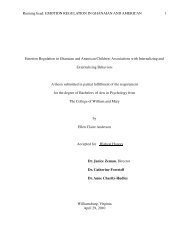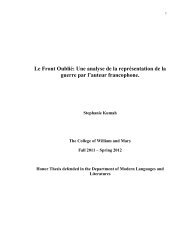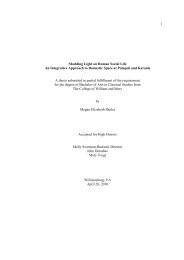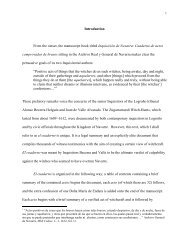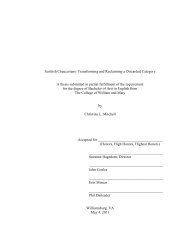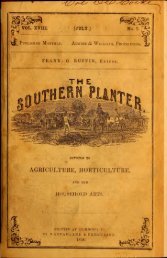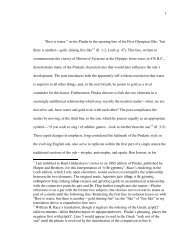Southern planter - The W&M Digital Archive
Southern planter - The W&M Digital Archive
Southern planter - The W&M Digital Archive
Create successful ePaper yourself
Turn your PDF publications into a flip-book with our unique Google optimized e-Paper software.
1859.] THE SOUTHERN PLANTER. 427<br />
From the Conservatory Journal.<br />
Relations of Air, Water, and Light, to<br />
Animal and Vegetable Life.<br />
BY CHARLES T. JACKSON, M.D., STATE AS-<br />
SAYER.<br />
When an animal draws air into its lungs,<br />
and then exhales it, the expired air no longer<br />
will support flame, but the lighted taper,<br />
inserted in a receiver filled with it, is in-<br />
'stantly extinguished.<br />
If we now bring a branch of a living<br />
plant, having foliage, into this receiver, and<br />
expose the whole to sunlight, in a few min-<br />
utes the air is restored to its original state<br />
and will support combustion.<br />
On analysis, we find that the air which<br />
has been breathed by an animal, has lost the<br />
chief part of its oxygen, which is converted<br />
into carbonic acid gas. This gas is the re-<br />
spiratory food of plants, and the leaves,<br />
which are their lungs, absorb the carbonic<br />
acid, and by aid of the sun's rays decom-<br />
pose it, converting its carbon into its carbonaceous<br />
juices, fibre and cells; while pure<br />
oxygen is exhaled and the air is again rendered<br />
fit for the respiration of animals.<br />
<strong>The</strong> same relations also exist in the action<br />
of the respiration of fishes, which draw from<br />
the air, dissolved in water, their respiratory<br />
element, while sub-aqueous vegetation ab-<br />
sorbs their exhaled carbonic acid, and re-<br />
place it by pure oxygen. <strong>The</strong> gills of fishes<br />
act in the same physiological manner as the<br />
lungs of air-breathing animals. <strong>The</strong>y cannot<br />
decompose water, rich as it is in combined<br />
oxygen, but they depend on the small<br />
proportion of free oxygen which is dissolved<br />
in all water that has been properly ventila-<br />
ted.<br />
<strong>The</strong>se facts have now come to be popularly<br />
apprehended, since the aqua-vivarium has<br />
become so common in many households.<br />
We shall proceed now to some details and<br />
generalizations on this and related subjects,<br />
to which we invite the reader's attention.<br />
We live at the bottom of a great atmospheric<br />
ocean, between forty-five and fifty<br />
miles deep.* This ocean consists of nitrogen<br />
and oxygen gases, commingled, but not<br />
chemically combined. In addition to these<br />
two great components, there is a small proportion<br />
of carbonic acid gas, and variable<br />
* Recent researches seem to indicate that the<br />
height of the atmosphere is between seventy and<br />
ninety-nine miles. See Kaeintz' Meteorology,<br />
note by Charles Martins.<br />
proportions of aqueous vapor, also dissolved<br />
and intimately commingled with them. By<br />
the law of diffusion, gases become, in a short<br />
time, intimately and uniformly mixed, so<br />
that, though of different densities, they do<br />
not separate by gravitation. Were it not<br />
for this law, animals at the surface of the<br />
earth would soon be drowned in a stratum<br />
of carbonic acid gas, it being much heavier<br />
than air. Aqueous vapor is held in solution<br />
in the air, at a certain tension in ratio to the<br />
temperature of the air. When the air is<br />
cooled to a certain point, a portion of the<br />
water is condensed in the form of rain, snow,<br />
or hail; and when the earth, by radiation<br />
of heat, has its temperature lowered below<br />
the dew point, a deposition of moisture takes<br />
place on its surface.<br />
<strong>The</strong> atmosphere consists of<br />
By weight. By hulk or measure.<br />
Oxygen, 23.10 20.90<br />
Nitrogen, 76.90 79.10<br />
100.00 100.00<br />
In addition, we have in bulk, on the aver-<br />
age, 4-10,000, four ten thousandths of carbonic<br />
acid, and occasionally a little carbu-<br />
retted hydrogen, and ammonia; but these<br />
two last are accidental and irregular in their<br />
presence, depending chiefly on the abodes<br />
of men for their production.<br />
Carbonic acid, in proportion of from three<br />
to six ten thousandths of the atmosphere's<br />
bulk, is essential to vegetable life, but much<br />
more of it would prove injurious to animals.<br />
Hence, Nature has nicely adjusted the pow-<br />
ers of animal and vegetable life, so as to<br />
keep the atmosphere always exactly balanced<br />
with its due proportions of these gases, and<br />
by the winds, or atmospheric currents, prevents<br />
an undue accumulation of injurious<br />
gases from taking place in any portion of<br />
the globe. Simple and beautiful as these<br />
laws are, we should not neglect to contemplate<br />
and admire them.<br />
If we now look to the composition of wa-<br />
ter, we shall find that it consists of,<br />
By weight.<br />
Oxygen, 88.91<br />
Hydrogen, 11.09<br />
By measure of gases.<br />
1<br />
2<br />
condensed and combin-<br />
100.00 ed chemically.<br />
Rain water contains, dissolved in it, on<br />
the average, about 2 J per cent, of its bulk<br />
of air, in which the proportions of oxygen<br />
are, according to Guy Lussac and Humboldt,




